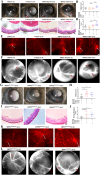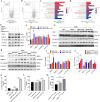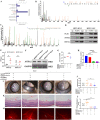A de novo missense mutation in MPP2 confers an increased risk of Vogt-Koyanagi-Harada disease as shown by trio-based whole-exome sequencing
- PMID: 37828081
- PMCID: PMC10616125
- DOI: 10.1038/s41423-023-01088-9
A de novo missense mutation in MPP2 confers an increased risk of Vogt-Koyanagi-Harada disease as shown by trio-based whole-exome sequencing
Abstract
Vogt-Koyanagi-Harada (VKH) disease is a leading cause of blindness in young and middle-aged people. However, the etiology of VKH disease remains unclear. Here, we performed the first trio-based whole-exome sequencing study, which enrolled 25 VKH patients and 50 controls, followed by a study of 2081 VKH patients from a Han Chinese population to uncover detrimental mutations. A total of 15 de novo mutations in VKH patients were identified, with one of the most important being the membrane palmitoylated protein 2 (MPP2) p.K315N (MPP2-N315) mutation. The MPP2-N315 mutation was highly deleterious according to bioinformatic predictions. Additionally, this mutation appears rare, being absent from the 1000 Genome Project and Genome Aggregation Database, and it is highly conserved in 10 species, including humans and mice. Subsequent studies showed that pathological phenotypes and retinal vascular leakage were aggravated in MPP2-N315 mutation knock-in or MPP2-N315 adeno-associated virus-treated mice with experimental autoimmune uveitis (EAU). In vitro, we used clustered regularly interspaced short palindromic repeats (CRISPR‒Cas9) gene editing technology to delete intrinsic MPP2 before overexpressing wild-type MPP2 or MPP2-N315. Levels of cytokines, such as IL-1β, IL-17E, and vascular endothelial growth factor A, were increased, and barrier function was destroyed in the MPP2-N315 mutant ARPE19 cells. Mechanistically, the MPP2-N315 mutation had a stronger ability to directly bind to ANXA2 than MPP2-K315, as shown by LC‒MS/MS and Co-IP, and resulted in activation of the ERK3/IL-17E pathway. Overall, our results demonstrated that the MPP2-K315N mutation may increase susceptibility to VKH disease.
Keywords: Annexin A2; De novo mutation; ERK3/IL-17E pathway; Membrane palmitoylated protein 2; Vogt–Koyanagi–Harada disease; Whole exome sequencing.
© 2023. The Author(s).
Conflict of interest statement
All authors declare no competing interests.
Figures






Similar articles
-
OR11H1 Missense Variant Confers the Susceptibility to Vogt-Koyanagi-Harada Disease by Mediating Gadd45g Expression.Adv Sci (Weinh). 2024 Mar;11(11):e2306563. doi: 10.1002/advs.202306563. Epub 2024 Jan 2. Adv Sci (Weinh). 2024. PMID: 38168905 Free PMC article.
-
A variant of CLEC16A gene confers protection for Vogt-Koyanagi-Harada syndrome but not for Behcet's disease in a Chinese Han population.Exp Eye Res. 2015 Mar;132:225-30. doi: 10.1016/j.exer.2015.01.004. Epub 2015 Jan 7. Exp Eye Res. 2015. PMID: 25576669
-
JAK1, but not JAK2 and STAT3, confers susceptibility to Vogt-Koyanagi-Harada (VKH) syndrome in a Han Chinese population.Invest Ophthalmol Vis Sci. 2013 May 9;54(5):3360-5. doi: 10.1167/iovs.13-11615. Invest Ophthalmol Vis Sci. 2013. PMID: 23611997
-
Vogt-koyanagi-harada syndrome.Curr Eye Res. 2008 Jul;33(7):517-23. doi: 10.1080/02713680802233968. Curr Eye Res. 2008. PMID: 18600484 Review.
-
The emerging role of epigenetics and gut microbiota in Vogt-Koyanagi-Harada syndrome.Gene. 2022 Apr 15;818:146222. doi: 10.1016/j.gene.2022.146222. Epub 2022 Jan 29. Gene. 2022. PMID: 35092860 Review.
Cited by
-
BARD1-mediated stabilization of METTL14 promotes retinal neovascularization by m6A-modifying MXD1 mRNA on a YTHDF2-dependent manner.Theranostics. 2025 Apr 13;15(11):5481-5498. doi: 10.7150/thno.110122. eCollection 2025. Theranostics. 2025. PMID: 40303324 Free PMC article.
-
m6A-methylase METTL3 promotes retinal angiogenesis through modulation of metabolic reprogramming in RPE cells.J Neuroinflammation. 2024 Nov 6;21(1):289. doi: 10.1186/s12974-024-03279-1. J Neuroinflammation. 2024. PMID: 39506758 Free PMC article.
-
Comparison of GWAS results between de novo tinnitus and cancer treatment-related tinnitus suggests distinctive roles for genetic risk factors.Sci Rep. 2024 Nov 14;14(1):27952. doi: 10.1038/s41598-024-78274-w. Sci Rep. 2024. PMID: 39543288 Free PMC article.
-
Autophagy-induced NR2F1 activation promotes the apoptosis of lens epithelial cells and facilitates cataract-associated fibrosis through targeting STAT3.Genes Dis. 2025 Jan 28;12(5):101549. doi: 10.1016/j.gendis.2025.101549. eCollection 2025 Sep. Genes Dis. 2025. PMID: 40641526 Free PMC article.
-
OR11H1 Missense Variant Confers the Susceptibility to Vogt-Koyanagi-Harada Disease by Mediating Gadd45g Expression.Adv Sci (Weinh). 2024 Mar;11(11):e2306563. doi: 10.1002/advs.202306563. Epub 2024 Jan 2. Adv Sci (Weinh). 2024. PMID: 38168905 Free PMC article.
References
Publication types
MeSH terms
Substances
LinkOut - more resources
Full Text Sources
Molecular Biology Databases
Miscellaneous

